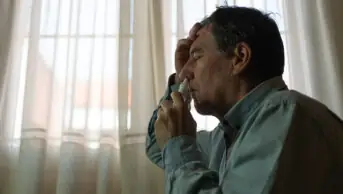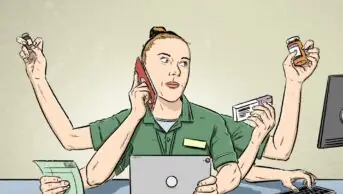
Jeff Dalton / Alamy Stock Photo
It’s 4pm on a Saturday afternoon; someone comes into your pharmacy saying they have forgotten to ask for a repeat prescription of their normal medication and will run out before their GP reopens on Monday.
For years, patients and pharmacists in some parts of the UK have had very limited options in these situations. Pharmacists could issue an emergency supply[1]
– for which the patient would have to pay a fee — or, in some cases, pharmacists might decide to treat the medicine as a ‘loan’, with a prescription expected to arrive within a couple of days.
In England, when patients are provided with an emergency supply, they would normally pay the full cost of the medication plus a fee for the service, even if they are exempt from the prescription charge.
Some patients will try to see a GP or other prescriber to get an NHS prescription – perhaps through NHS 111, a walk-in centre, GP out-of-hours service or even A&E, either because they are unaware of the option to seek an emergency supply direct from a pharmacy or because they baulk at the idea of having to pay for their medicines.
Over the past few years, a number of local schemes have been set up in England to cover this gap in services[2],
[3]
— and a Scotland-wide scheme was introduce a decade ago[4]
. These schemes have allowed patients to get their forgotten medicines at the normal cost either through contacting NHS 111 or as a ‘walk-in’ at a pharmacy.
Now NHS England has introduced the NHS urgent medicine supply advanced service (NUMSAS)[5]
, which has already been rolled out in a number of pilot sites with the aim of going live across the country by Easter 2017. It was not negotiated with the profession and is not a universal service — pharmacies will have to opt in.
But is the NUMSAS going to make life easier for patients, pharmacists and the rest of the NHS – and will it improve on the existing schemes, which are already well-established in some areas? Robbie Turner, director for England at the Royal Pharmaceutical Society, says: “We think the service is a first but important step towards better integration of community pharmacy in the wider urgent and emergency care system.” But he adds some parts of the service could be improved to make it easier to deliver.
Urgent supply: the options
Under the NUMSAS scheme, patients need to ring NHS 111 where, if appropriate, they will be given the details of a pharmacy taking part and asked to contact them. This pharmacy will then be sent the patient’s details electronically (for which an nhs.net email address is needed) and may — at the pharmacist’s discretion — dispense the prescription to the patient who pays the prescription fee, or not, as they normally would. If the pharmacist is not happy to dispense the medicine, the pharmacy should refer the patient to an appropriate service – such as the out-of-hours GP service.
Patients can’t just turn up at their nearest pharmacy and get their medications — unless they are willing to pay privately. All requests have to be routed through NHS 111. And, with sign up from pharmacies limited at present and uncertain in future, patients wanting to make use of the scheme could have to travel some distance to get their medicines.
“Many of the locally commissioned schemes – some of which are still in existence and will continue to run alongside the pilots – were richer schemes,” says Alistair Buxton, director of NHS services at the Pharmaceutical Services Negotiating Committee, the national negotiating body for community pharmacy contractors in England. PSNC member Gary Warner goes further and says the new system is “massively complicated” and introduces the challenge of moving people away from existing ways of working.

Source: Pharmaceutical Services Negotiating Committee
PSNC member Gary Warner says the potential value of the scheme in reducing pressure on other parts of the NHS is not reflected in what is being paid to pharmacists to deliver it
There is also concern that some local services may no longer be commissioned, although NHS England says the evaluation of the pilots will look at the relationship with ‘walk-in services’ and that it is important these services remain in place.
We believe that the local scheme has advantages over the national one
Some of the older schemes have been popular with both patients and pharmacists. In Cornwall, 10,000 people each year use a scheme commissioned by the local clinical commissioning group that has been running for 10 years during peak holiday times. More recently, the scheme has also run in January and February to help relieve pressure on other services[6]
. Phillip Yelling, chief executive of the Cornwall local pharmaceutical committee (LPC), hopes the scheme can co-exist with the national one. “We believe that the local scheme has advantages over the national one,” he says. “If we have to convert to the national one we have to send the patient away [to ring NHS 111].”
In Scotland, patients can get an emergency supply of medicines by contacting any community pharmacy – although they can’t do it for two consecutive prescriptions, as a safeguard against misuse. Remuneration for this service is wrapped up in the establishment fee paid to all pharmacies.
More than a quarter of a million prescriptions were filled in this way during 2014–2015, according to Adam Osprey, policy and development pharmacist at Community Pharmacy Scotland, which represents pharmacy contractors in negotiations with NHS Scotland. But the scheme is also strengthening the role of community pharmacies as they become the ‘natural’ place to sort out health problems, he adds.
Other local schemes are already accessed via NHS 111. In the North East and Cumbria, a scheme that ran between December 2014 and April 2015 involved all sites, not just selected ones[2]
. At the time, about 15% of NHS 111 callers at times when GP surgeries were likely to be closed were asking for emergency medicines. Nationally, about 2% of callers to NHS 111 — around 200,000 people each year — are seeking an emergency supply of their medicines, according to NHS England.
A backward step?
Hamde Nazar, a lecturer in pharmacy practice at Durham University who evaluated the Cumbrian scheme, says NHS 111 call handlers may not be confident referring to pharmacists for urgent medications. “They are not used to doing it or to negotiating with patients over pharmacies,” she says. If patients have to travel some distance, they may be unhappy at the call handler’s suggestion.
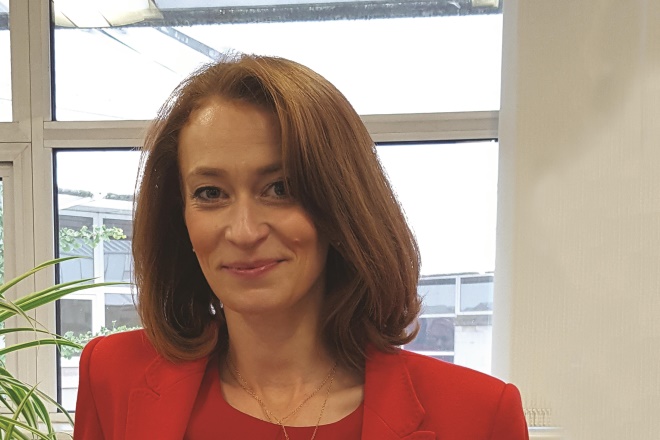
Source: Courtesy of Hamde Nazar
Hamde Nazar, a lecturer in pharmacy practice at Durham University, says NHS 111 call handlers may not be confident referring to pharmacists for urgent medications
This sort of problem is affecting some of the pilot areas for the national scheme. Vanessa Taylor, professional executive officer for East Sussex LPC, which has several pilot sites, says that call handlers’ lack of familiarity with the system can lead to inadequately filled in referral emails coming to pharmacies: not giving dose amounts or precise types of medication, for example. This can be difficult to resolve unless the patient is aware of the dose, has a prescription slip or the pharmacy can access their records. In Brighton and Hove, this issue has led to some patients being referred back to NHS 111 rather than onto another healthcare professional. Patients seeking controlled drugs are also being referred to pharmacists when they shouldn’t and are having to re-enter the system via NHS 111, says Taylor.
There is an efficiency issue because we are jumping between systems but there is also a risk issue that you might miss something when doing so
Other practical issues concern IT and the ‘clunkiness’ of the scheme, which involves pharmacists having to switch between computer systems, find an email address for the patient’s GP practice and then to hand write details of the prescription.
“It is very disappointing [that] pharmacists [have] to revert back to hand writing on the token,” says Shanel Raichura, a practising pharmacist who is also director of pharmacy at EMIS Health, a healthcare software company. The hand written tokens show a prescription has been issued and claims for reimbursement are sent by post.
“There is an efficiency issue because we are jumping between systems but there is also a risk issue that you might miss something when doing so,” says Raichura. As a community pharmacist, Raichura has provided the Pharmacy Urgent Repeat Medicines scheme, an urgent supply scheme operating in London, which he describes as “more advanced from an IT perspective” than the national scheme.
He suggests some sort of direct integration between NHS 111 and the pharmacy patient medication record would be helpful. “There is a lot of fiddling about; I should be able to receive referrals from NHS 111 via the spine.”
PharmOutcomes — a web-based system provided by the PSNC to pharmacy contractors and designed to help community pharmacists deliver services and for commissioners to manage them[7]
— has recently been tweaked to make it interoperable with the NUMSAS service and enable some administrative tasks to be completed through it: the ability to interface with NHS 111, however, comes at a financial cost to commissioners and only a few in the pilot areas have signed up for it so far.
An immediate issue is that to join the national scheme, pharmacies need to ensure they have a premises-specific shared NHSmail mailbox to receive details of referrals from NHS 111. There have been some delays in obtaining these mailboxes, with a rush of applications from pharmacies wanting to apply for quality payments under the new community pharmacy contract imposed by NHS England in October 2016.
A viable option
Payment for a consultation under the NUMSAS scheme is £10. A fee of £1.50 will be made for the first item, and £0.50 for each additional item supplied. During the evaluation phase, pharmacies will be paid an extra £2.50 for collecting additional information.
Opening hours could influence the decision to get involved: for some pharmacies — those open late into the evening and those open long hours at weekends — the scheme may provide useful extra income, especially if they can benefit from some economies of scale. But for many, the rewards will be small. LloydsPharmacy says around half its sites, including those in Sainsburys, will take part, with a focus on those open past 6pm and at weekends. None are live so far (early March).
“It plays to the strengths of [pharmacies] with long opening hours,” says Warner.
The PSNC is concerned about the funding levels on offer and has developed a spreadsheet, available via its website[8]
, to allow contractors to calculate costs and income to help them decide whether opting into the scheme is financially viable.
Some aspects of the national scheme look to be fairly onerous for pharmacists. They will be expected to chase patients directed to them by NHS 111 if the patient doesn’t turn up or contact the pharmacy.
However, there are positives. Feedback to GPs is likely to be better than with the old emergency supply route: GPs are often unaware that medicines have been dispensed in this way[2],
[9]
. With both GPs and community pharmacists aware of the supply, there may be more opportunities to work with patients who frequently forget to order their repeat prescriptions to encourage better compliance.
NHS 111 referrals feel like part of the solution, but potentially there is a risk of increasing use of NHS 111
Use of the scheme will depend on public awareness, but NHS England does not appear to be actively promoting it. In part, this is deliberate – to stop patients seeing the scheme as an easy option if they forget to collect prescriptions. Martin Mandelbaum, chief executive of the LPCs in Surrey and West Sussex, says there is a need to educate people not to forget their repeat prescriptions but he acknowledges that access to a surgery can be difficult for some working people. If GPs are open on a Saturday, why don’t they staff surgeries with a receptionist and allow people to collect prescriptions, he asks?
While the NUMSAS scheme may reduce pressure on other parts of the service it is uncertain what the scheme will mean for NHS 111. “NHS 111 referrals feel like part of the solution — an important part of the solution — but potentially there is a risk of increasing use of NHS 111,” says Nick Hunter, chief officer at Nottinghamshire LPC. He says more emphasis should be put on encouraging uptake of electronic repeat prescribing, which could help many patients get their medications with less hassle and no need to involve NHS 111.
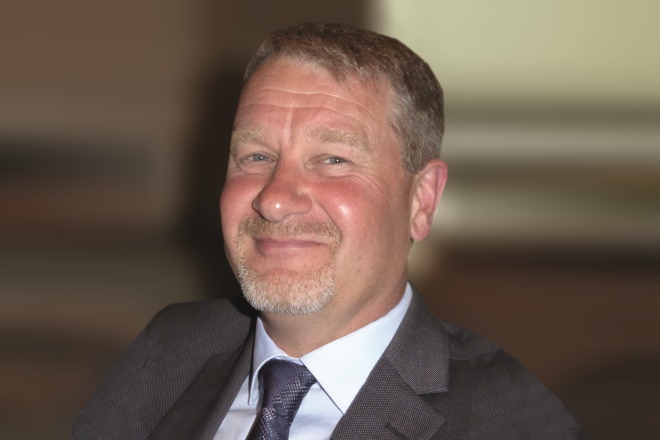
Source: Courtesy of Nick Hunter
Nick Hunter, chief officer at Nottinghamshire LPC, says more emphasis should be put on encouraging uptake of electronic repeat prescribing
So will pharmacies sign up for the new scheme? Warner is uncertain: “As a contractor I would… at best break even and [if it amounts to] half an hour’s work, [it] will mean I make a loss on it.” He suggests the potential value of the scheme in reducing pressure on other parts of the NHS is not reflected in what is being paid to pharmacists to deliver it.
A slow burn
While the scheme has been slow to get off the ground in some areas, it is beginning to have an impact in others.
In Nottinghamshire, the existing NHS 111 contract stipulated no major changes should be introduced in December 2016, so that pushed back the NUMSAS implementation date. Cambridgeshire – another early pilot – has around six pharmacies offering the service and there is evidence that it is reducing pressure on other parts of the health service (see ‘The early adopter’), with a third of patients calling NHS 111 with medicine queries directed to it in one recent week. In Brighton and Hove, a couple of pharmacies joined the scheme in December 2016 and numbers have now increased to between 15 and 20, according to Taylor.
A lot of pharmacies are waiting to see if some of the problems are resolved before doing this
“A lot of pharmacies are thinking twice before doing this,” she says. “They are waiting to see if some of the problems are resolved.” Many are already working flat out to meet deadlines for quality payments, she adds. However, Easter – with many GP surgeries closed for four days – could be a test for NUMSAS, which by then will be running in most areas.
Rob Darracott, chief executive of Pharmacy Voice, an association of three pharmacy trade bodies, is more optimistic. He hopes that those evaluating NUMSAS will also look at other emergency supply schemes and draw on the elements that have made them successful. And he points out the ultimate aim of schemes such as this should be to phase themselves out of existence by ensuring that patients don’t run out of their medicines.
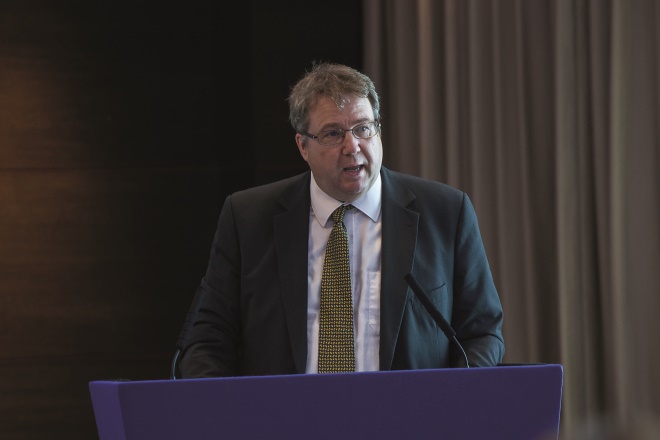
Source: Courtesy of Pharmacy Voice
Rob Darracott, chief executive of Pharmacy Voice, hopes that those evaluating NUMSAS will also learn from other emergency supply schemes and draw on the elements that have made them successful
“We can pick holes in a lot of these [schemes] but actually we don’t want people to run out of medicines they use regularly,” he says. “We have the opportunity to make the case for community pharmacy services as the first port of call.”
Raichera, too, suggests that the longer-term picture will outweigh the immediate issues: “If you don’t provide this sort of service you are not going to be given the opportunity to flourish and show what pharmacy can do. Sometimes you have to do these things even if there is not much profit in it.”
But some fail to see any immediate advantage over existing emergency supply schemes: “Given what we already have in place [locally], I don’t think that NHS 111 or other out-of-hours services will really be helped,” says Hunter. ”I doubt that it will make much difference. If it does, it will take a while.”
The early adopter
Numark Pharmacy in Cambridge was one of a handful in the area to join the pilot phase of the NHS urgent medicine supply advanced service (NUMSAS) in December 2016 as one of the earliest adopters. The pharmacy opens 100 hours a week, so was ideally suited to offer patients an emergency supply service when their GP was closed. Previously, there was no local provision for patients who forgot their prescriptions, other than the traditional emergency supply route, which meant patients would have to pay for private dispensing.
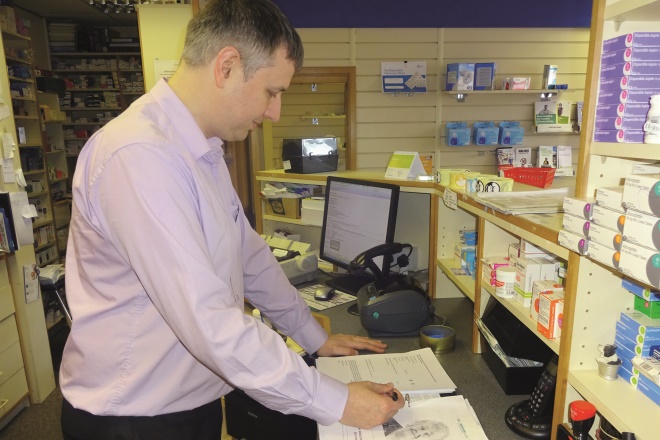
Source: Courtesy of Jody Butler
Jody Butler, of Numark Pharmacy in Cambridge, says patients appreciate the new scheme
By the beginning of February 2017, the pharmacy was dealing with one to two referrals from NHS 111 each evening and three to four on Saturdays and Sundays.
Pharmacist Jody Butler says that patients from as far away as Huntingdon and Royston — some 20 and 13 miles away, respectively — have been referred to the pharmacy, reflecting the low numbers of sites taking part in the pilot.
“It has been working well and patients really appreciate it,” he says. “It is stopping a number of charges to patients and referrals to out–of-hours doctors because that is what we ended up doing with people who did not want to pay.”
Butler says the form filling is less onerous than first appeared and the payment is “not derisory” – although any economies of scale from the service may diminish if more pharmacies sign up. And while having to use a paper-based system rather than sending forms electronically seems anachronistic, Butler says this may change as the system spreads.
Rita Bali, from the Cambridgeshire LPC, says: “Our early experiences do support our belief that there is significant scope for community pharmacies to ease the burden on other care providers.”
Emergency supply: the bigger picture
Pharmacists in parts of Europe, and in the United States, Canada and Australia — where prescription medicines supply is tightly regulated — all have the option to supply medicines in an emergency. Most systems allow for a short supply (three to five days) where the pharmacist is satisfied that the patient has been prescribed the treatment previously, the prescription medicine is needed urgently and that it is not practical for the patient to obtain a prescription without undue delay.
References
[1] Statutory Instruments. The Human Medicines Regulations 2012. No. 1916. London: The Stationery Office, 2012. Available at: http://www.legislation.gov.uk/uksi/2012/1916/contents/made (accessed March 2017)
[2] Nazar H, Nazar Z, Simpson J et al. Summative service and stakeholder evaluation of an NHS-funded community Pharmacy Emergency Repeat Medication Supply Service (PERMSS). BMJ Open. 2016;6:e009736. doi:10.1136/bmjopen-2015-009736
[3] NHS England Pharmacy Urgent Repeat Medication Service. London region. Pharmacy summary. Available at: https://www.england.nhs.uk/commissioning/wp-content/uploads/sites/12/2015/11/79-purm-pharmacy-summary.pdf (accessed March 2017)
[4] NHS Scotland. National patient group direction for urgent provision of repeat medicines, appliances and ACBS products. Available at: http://www.communitypharmacy.scot.nhs.uk/documents/unscheduled_care/Unscheduled_Care_Pharmacy_Guide_PGD_v21_sect_11_pdf.pdf (accessed March 2017)
[5] NHS England. NHS Urgent Medicine Supply Advanced Service Pilot: Community Pharmacy Service Specification. November 2016. Available at: https://www.england.nhs.uk/wp-content/uploads/2016/11/numsas-service-specification.pdf (accessed March 2017)
[6] Cornwall and Isles of Scilly Local Pharmaceutical Committee. Emergency supply service — service specification (ESS1). Available at: http://cornwalllpc.org/commissioned-services/urgent-medication-supply/ (accessed March 2017).
[7] PSNC. PharmOutcomes. Available at: http://psnc.org.uk/services-commissioning/pharmoutcomes/ (accessed March 2017)
[8] PSNC. Urgent medicine supply service. Available at: http://psnc.org.uk/services-commissioning/urgent-medicine-supply-service/ (accessed March 2017)
[9] Morecroft CW, Mackridge AJ, Stokes EC et al. Emergency supply of prescription-only medicines to patients by community pharmacists: a mixed methods evaluation incorporating patient, pharmacist and GP perspectives. BMJ Open 2015;5:e006934. doi: 10.1136/bmjopen-2014-006934m

